Create a professional CV now!
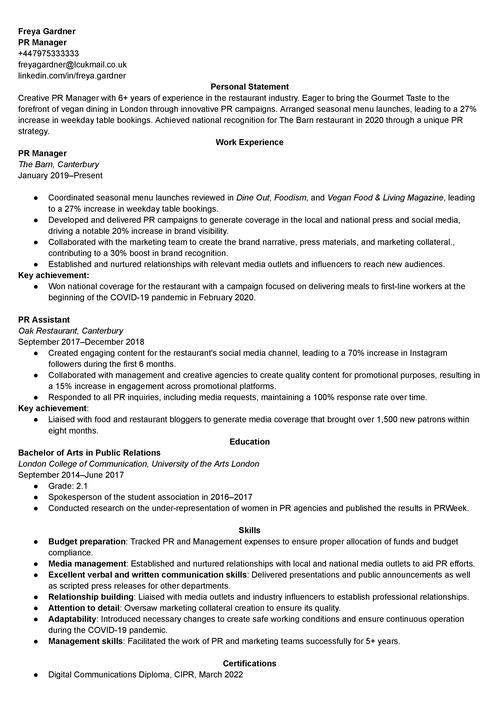 NO
NO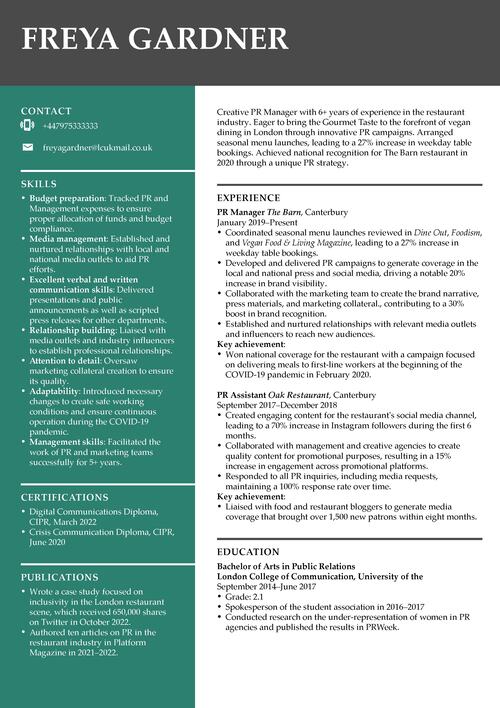 YES
YESOur customers were hired by:
Are you ready to embark on a new adventure? What’s more exciting than finding a new job—one that offers an opportunity to develop and provides satisfaction? The pursuit of your dream career starts right now, with a CV that will serve as your vehicle.
And I'm here to guide you on how to write a CV that not only highlights your strengths but also captures the attention of potential employers, paving the way for your next big opportunity.
Read on and learn how to write a CV to take you where you want to be in 10 years.
Create an effective CV in minutes. Choose a professional CV template and fill in every section of your CV in a flash using ready-made content and expert tips.
Create a professional CV now!
 NO
NO YES
YESWe created the sample on the right using our builder. See other good CV examples like this one.
Looking to improve your CV? These guides on how to write a CV for the UK job market might help:
Our analysis of 6 million CVs made with our builder reveals that*:
*The data comes from a period of the last 12 months (August 2023-August 2024).
A CV, derived from the Latin term “curriculum vitae,” meaning “course of life,” is a document utilised during job applications. It usually spans 1–2 pages and lets you summarise your work experience, education, and skills to attract potential employers. A CV is often sent along with a cover letter.
While various countries use different application documents, a curriculum vitae is a standard format in the UK. Knowing how to create a good CV is essential for making a positive first impression on potential employers and presenting your strongest points. It also allows recruiters to assess your suitability for a job quickly.
In a competitive job market, creating a strong CV can help you stand out from other applicants and increase your chances of being shortlisted for interviews. It’s a powerful tool in your job search, opening doors to new possibilities and enabling you to pursue your career goals confidently.
Before you get down to CV writing, I advise you to carefully read the job advertisement and make notes about the job requirements, position, and company. You’ll use this information to determine what to write in each section of your CV for work.
Make notes about the following things:
To compile such detailed information, look into:
Now, it’s a good idea to research the company’s website and social media to learn more about its objectives and culture. Your research should provide a first-light answer to the question: “What problem could the company be facing and trying to solve?”.
The above question is just a preface to how you’ll make a CV for job application. Because you need then to decide how you’ll solve the problems you’ve identified in the job posting. And you can do that by determining if either experience or skills speak in your favour. Once you have the answer, see which of the three most common CV formats you should be aiming at:
Let me show you a quick comparison of all the differences between these three UK CV formats:
Type of CV format | Chronological CV | Functional CV | Combination CV |
Order of sections |
|
|
|
Who is it for | All types of applicants | It’s best for creative professions, career changers, military transitioners, and candidates with gaps in work history | It’s best for senior-level applicants as well as career changers |
If you don’t prefer any of these styles, go with the chronological CV. Recruiters prefer this format, and it’s suitable for candidates of all experience levels. It’s also best suited for applicant tracking software used to scan job applications.
Start creating your CV by creating a header at the top of the document. The placement will depend on the template you’re using. Use the header space for your name, job title, and personal details.
How to make a UK CV header:
Here’s an example of how to make a UK CV header:
Freya Gardner
PR Manager
+447975333333
freyagardner@lcukmail.co.uk
linkedin.com/in/freya.gardner
Be careful when typing your email and phone number; always re-read them. A typo can make it impossible to reach you.
The next section of your curriculum vitae should summarise your qualifications for the desired position. Writing a personal statement is the best way to introduce yourself on a CV. But only when you tailor it to the role you want.
How to write a UK CV personal statement:
See an example:
Creative PR Manager with 6+ years of experience in the restaurant industry. Eager to bring the Gourmet Taste to the forefront of vegan dining in London through innovative PR campaigns. Arranged seasonal menu launches, leading to a 27% increase in weekday table bookings. Achieved national recognition for The Barn restaurant in 2020 through a unique PR strategy.
That might sound overwhelming if you’re writing a CV without work experience, but chin up! Instead of employment history, I recommend that you mention your academic background, volunteer work, or transferable skills. Show your understanding of the job and that you can handle it. Just like the applicant in the example below:
Driven Marketing graduate applying for a Digital Marketing Assistant position. Eager to apply content creation and social media marketing management knowledge to bring more traffic and build brand recognition at Leaf Flowering. Ran the university rowing team's Instagram and YouTube channels in 2020-2023. Gained hands-on content writing experience while volunteering at Cat Rescue & Rehome Fund in 2022.
If you want to make your job easier, leave this part of your UK CV blank, and move on to other sections. Fill it out after you complete the rest of your CV. You can later combine bits and pieces of information from different parts of your application.
A strong CV summary will convince the recruiter you’re the perfect candidate. Save time and choose a ready-made personal statement written by career experts and adjust it to your needs in the LiveCareer CV builder.
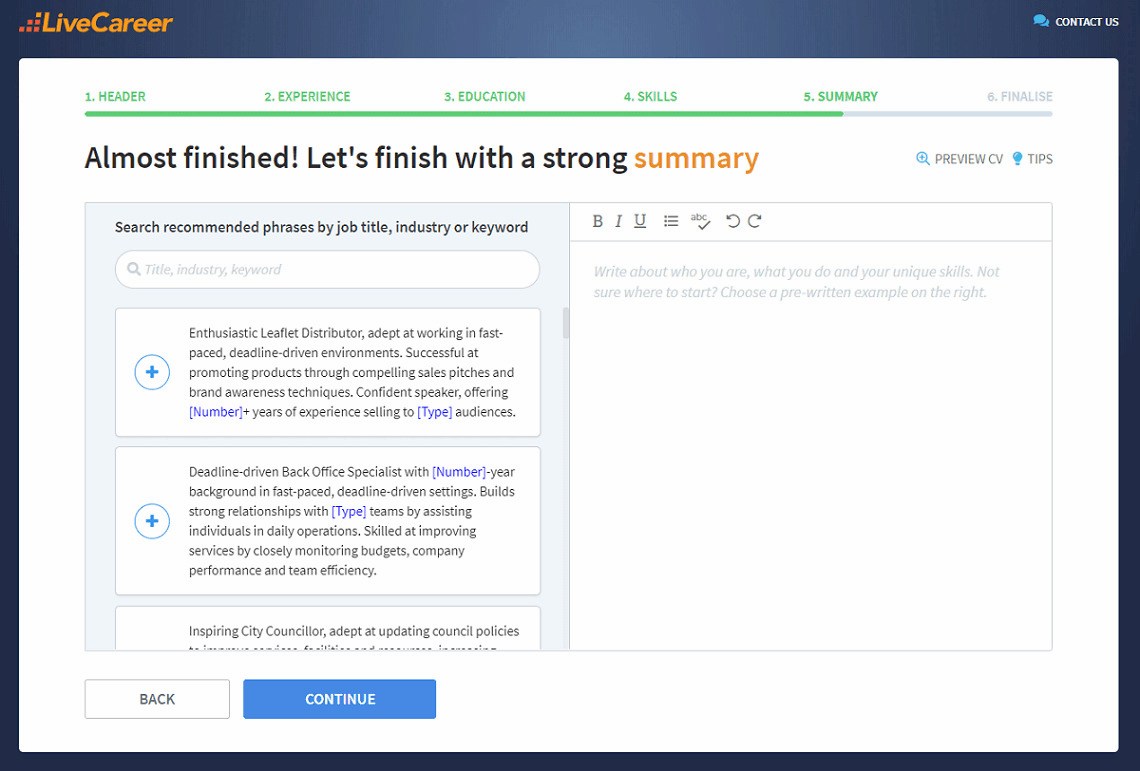
In the chronological format, your work experience section is vital. But it’s far from the truth that you need a simple listing of your previous jobs and responsibilities. To make the most out of this section, you should include specific details about your experience, such as the accomplishments you achieved and the skills you developed. Additionally, you should emphasise the impact of your work and how it helped to improve the company's bottom line.
Knowing how to do a CV work history well is priceless. Here, I explain what to do step by step:
Here’s a sample UK CV job description:
PR Manager
The Barn, Canterbury
January 2018–Present
Key achievement:
So, what makes this example work so well? Several factors: it includes measurable achievements that prove the applicant’s expertise, names awards they received, and uses action words to highlight the candidate’s initiative.
The next step to creating a great UK CV is the education section. No job application is complete without it. However, adding information about your educational background is more than a formality. If you know how to make the CV education section well, this part of your UK CV can become a real asset.
The amount of information you should provide depends on your professional experience:
Here’s how to make a CV’s education section:
Bachelor of Arts in Public Relations
London College of Communication, University of the Arts London
September 2014–June 2017
Employers want skilled workers, and that’s a fact. But the skills they expect depend on the job—a university professor needs different abilities than a financial advisor. Do you know what skills are expected of you? You can verify that using your job posting.
Here’s how to make a UK CV’s skills section:
Let me share an example:
What if the job posting doesn’t mention the required skills? Here’s a tip: Check the National Career Service job profiles. They include detailed descriptions of various professions and list the most common skills for the role.
What else should you write in a CV? You’ve completed the essential sections, so now it’s time for the extras. Bonus sections help make your CV more personal and allow you to provide more details about relevant skills and experience.
The most common CV's additional sections are:
Choose 2–3 sections from the list above that you believe will bring you benefits. Describe relevant accomplishments just like you would mention in the work history part. And use action verbs to highlight your initiatives.
Certifications
Memberships
Member of the Chartered Institute of Public Relations since January 2020
Publications
In business, first impressions matter. Make the most of it by creating a curriculum vitae that looks perfect.
If you want a quick and simple solution, try an online CV builder or find free CV templates that are already pre-formatted. But you can also design your curriculum vitae yourself using Word, Google Docs, or a similar app. They make CV writing much easier.
If you opt for the second solution, here’s how to create a CV layout:
Are you thinking of adding colour to your CV to stand out from the crowd? Be careful. Resources such as the London School of Economics Careers CV manual advise against it. If you wish to use colour, be subtle: use it to highlight your name, headings, or bullet points, and stick to one colour only.
It looks like your CV is almost ready to win you the job you want. But before you send it, consider these extra tips to make your UK-standard CV even better:
A bit overwhelmed with the amount of information to remember? Don’t worry. Here’s a short checklist for you to go through once you’re done writing your CV:
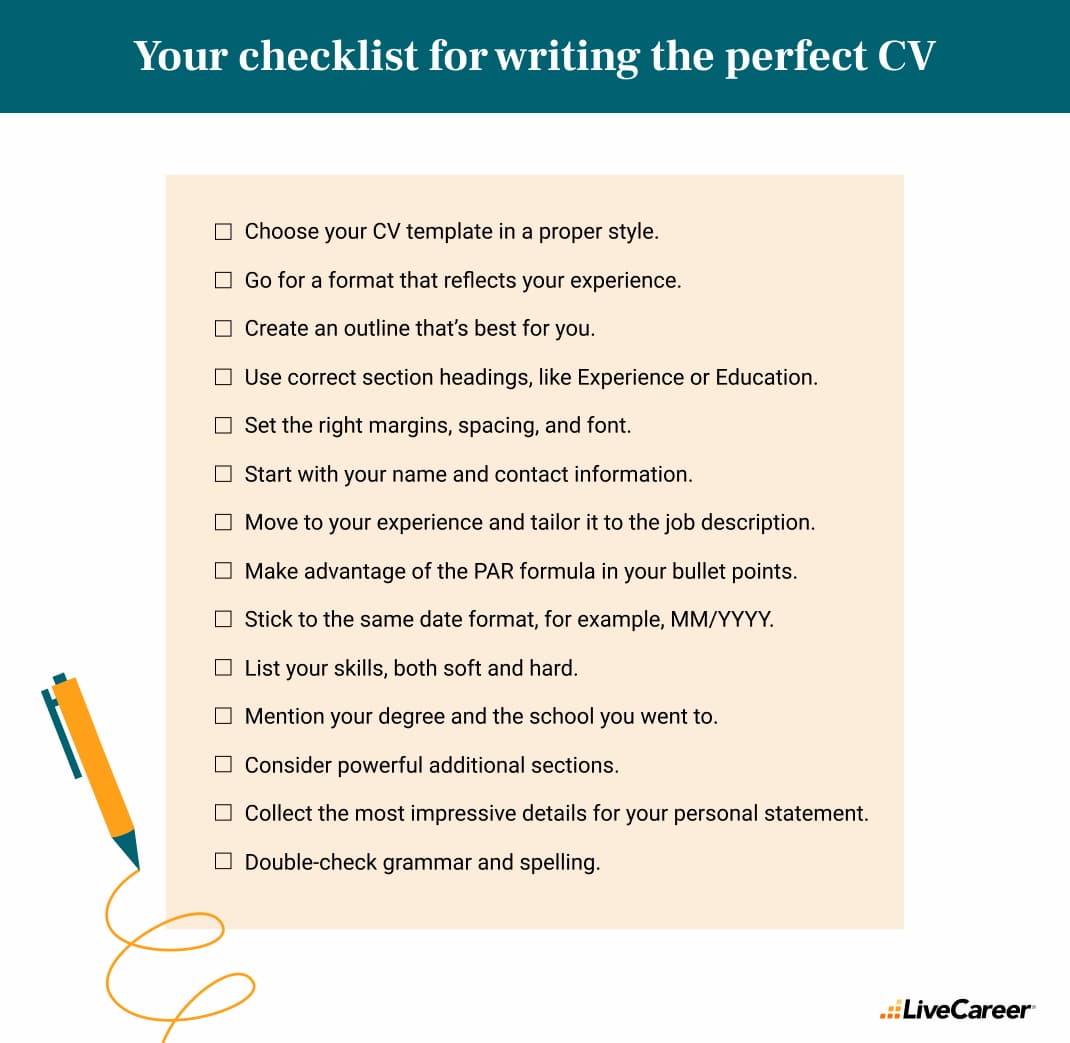
Freya Gardner
PR Manager
+447975333333
freyagardner@lcukmail.co.uk
linkedin.com/in/freya.gardner
Personal Statement
Creative PR Manager with 6+ years of experience in the restaurant industry. Eager to bring the Gourmet Taste to the forefront of vegan dining in London through innovative PR campaigns. Arranged seasonal menu launches, leading to a 27% increase in weekday table bookings. Achieved national recognition for The Barn restaurant in 2020 through a unique PR strategy.
Work Experience
PR Manager
The Barn, Canterbury
January 2019–Present
Key achievement:
PR Assistant
Oak Restaurant, Canterbury
September 2017–December 2018
Key achievement:
Education
Bachelor of Arts in Public Relations
London College of Communication, University of the Arts London
September 2014–June 2017
Skills
Certifications
Memberships
Member of the Chartered Institute of Public Relations since January 2020
Publications
You don’t have to be a CV writing expert. In the LiveCareer CV builder you’ll find ready-made content for every industry and position, which you can then add with a single click.
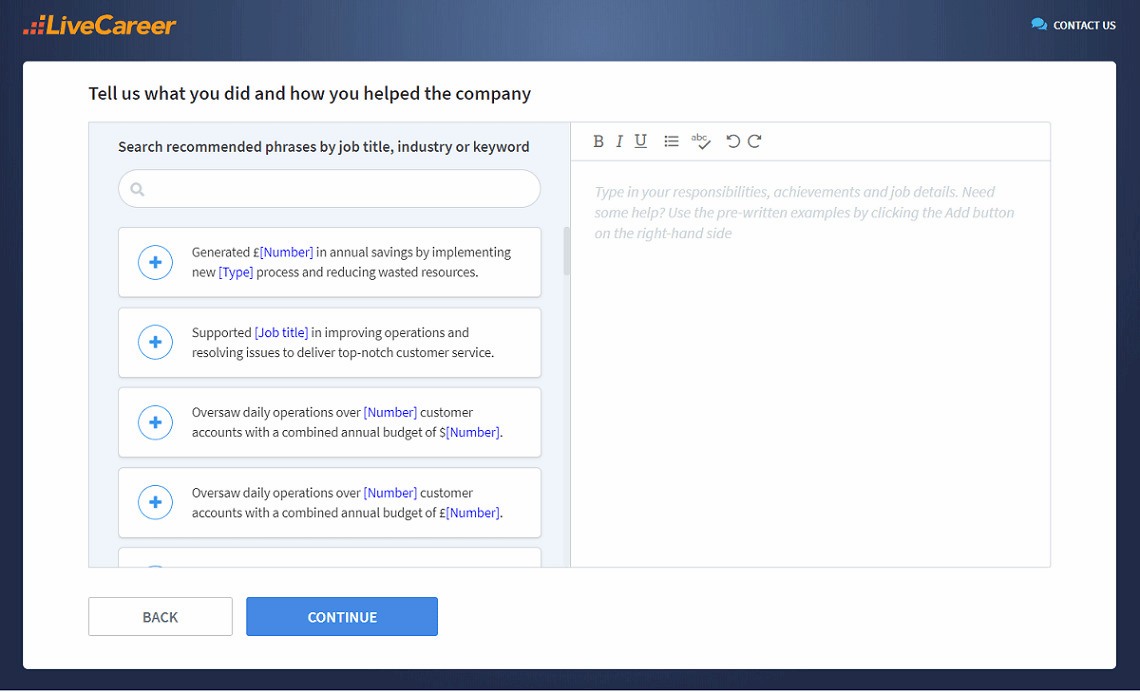
Thank you for taking the time to read this guide that explains how to do a CV. Now that you know how to write one, maybe you’d like to share tips for other applicants? Or do you need some more help? Let me know in the comments below.
Our editorial team has reviewed this article for compliance with Livecareer’s editorial guidelines. It’s to ensure that our expert advice and recommendations are consistent across all our career guides and align with current CV and cover letter writing standards and trends. We’re trusted by over 10 million job seekers, supporting them on their way to finding their dream job. Each article is preceded by research and scrutiny to ensure our content responds to current market trends and demand.
Reverse-chronological CV format is the best one, according to career experts. It focuses on work experience and lists jobs from the most recent to the oldest, highlighting professional accomplishments. The chronological CV is best for experienced candidates, but it’s easy to adapt for all candidates.
A good CV is easy to follow, concise, and visually appealing. It has the necessary CV sections, such as a header with contact information, personal statement, work experience, education and skills, and a few additional sections—all packed in a good CV layout.
Here’s how to ensure your CV looks professional in 2025:
The five main parts of a CV include the header with your name and contact details, personal statement, work experience, education, and skills. In the reverse-chronological format, the work experience section is the most extensive part of a CV.
You can make your CV using a dedicated CV builder where hiring professionals will guide you or create a document in a word-processing application. If you want to create a perfect CV from scratch, follow the steps below:
To make an effective teenager CV, consider your achievements at school and from other extracurricular activities relevant to the job you want. Use them to demonstrate your skills and knowledge that you can translate to success at work.
Here’s how you can write a CV for a 16-year-old:
About the author
Since 2013, the LiveCareer UK team has shared the best advice to help you advance your career. Experts from our UK editorial team have written more than one hundred guides on how to write the perfect CV or cover letter.
Rate this article:
How to write a cv
Average:

Write a hospitality CV that will get the job. Read our guide and learn how to make your CV for hospitality stand out from the crowd with top examples.
Whether you're writing a graduate software developer CV, junior software developer CV or senior software developer CV, don't let poor UX let you down!
See great customer service CV examples that’ll help you whether you need to write a CV for customer service assistant jobs or a customer service manager CV.
Our customers were hired by: